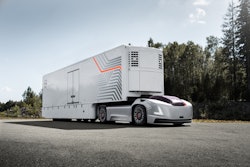
Just four years after the U.S. Environmental Protection Agency finalized a sweeping set of regulations aimed at cutting emissions from heavy-duty trucks and tractors by 25 percent by 2027, the EPA is eyeing new federal regulations to further tighten heavy-duty truck emissions and to create a so-called “50-state program” that harmonizes emissions standards nationally.
EPA Administrator Andrew Wheeler on Monday announced an advanced notice of proposed rulemaking (ANPRM), part of the Trump EPA’s Cleaner Trucks Initiative, that seeks input from the public and from trucking industry stakeholders about the next phase of regulations — chiefly, means to curb output of nitrogen oxide (NOx) and other air pollutants, Wheeler said.
Wheeler was flanked by representatives from the American Trucking Associations, the Owner-Operator Independent Drivers Association, the Truck and Engine Manufacturers Association and the Diesel Technology Forum at Monday’s announcement.
“The U.S. has made major reductions in NOx emissions, but through this initiative we will continue to reduce emissions, while spurring innovative new technologies, ensuring heavy-duty trucks are clean and remain a competitive method of transportation,” Wheeler said.
The 97-page ANPRM was posted online Monday by EPA, though it hasn’t yet been published in the Federal Register. Once published, stakeholders and the public can comment for 30 days. In his address Monday — and in the ANPRM — EPA says it intends to work more closely with manufacturers and other industry stakeholders to develop the new regulations. However, any formal regulations stemming from the ANPRM are likely years away, as rulemakings generally take several years to move from the ANPRM stage to a final, published rule.
In the document, EPA credits previous rounds of emissions regulations — and technologies like exhaust aftertreatment — with reducing heavy-duty truck tailpipe emissions of NOx and particulate matter by 90%. Likewise, EPA said it didn’t want to interfere with the industry’s ongoing work to meet Phase II tractor-trailer regulations finalized in 2016.
However, EPA says it has identified high NOx emissions during engine warmup and idling periods and when emissions controls deteriorate over time, as well as in crankcases that can emit emissions. These areas, as well as an overhaul of engine certification procedures, are targets for the next phase of emissions standards, the ANPRM notes.
Per EPA’s notice, “Heavy-duty vehicles continue to be a significant source of NOx emissions now and into the future. While the mobile source NOx inventory is projected to decrease over time, recent
emissions modeling indicates that heavy-duty vehicles will continue to be one of the largest
contributors to mobile source NOx emissions nationwide in 2028.”
EPA points to California’s stringent emissions standards as a potential example to follow — an area where EPA specifically requests input from the public and from industry stakeholders. However, EPA says it will press for a coordinated approach to emissions standards, mostly intended to block states from pursuing their own programs and, thus, making it difficult for engine and vehicle manufacturers (and other industry stakeholders) to develop and implement emissions reductions tech.
Other areas EPA says it seeks input on are: emissions control and monitoring technologies; durability of emissions control systems like exhaust aftertreatment; fuel quality; hybrid, battery-electric power, fuel cell and other alternative fuels; emissions testing and certification procedures; “in-use” standards (which would require vehicles to meet emissions standards at certain mileage thresholds); emissions education and incentives; longer warranties for emissions control systems and more. Read the full document at this link.
In addition to tightening and unifying emissions standards, other goals of the Cleaner Trucks Initiative are, EPA says, to leverage modern communications and computing technologies, provide proper lead time for manufacturers to meet any new requirements, to streamline regulatory requirements and to improve vehicle reliability.
Top brass at ATA and OOIDA applauded EPA’s proposal.
“ATA is committed to continuing to work closely with EPA on developing the next generation of low-NOx emitting trucks through the Cleaner Trucks Initiative. To this end, the trucking industry seeks one national, harmonized NOx emissions standard that will result in positive environmental progress while not compromising truck performance and delivery of the nation’s goods,” said ATA’s Bill Sullivan, executive VP of advocacy.
“Serious problems with earlier rulemakings have left small-business truckers justifiably wary of new emissions reduction proposals. However, over the last year, representatives of the EPA have gone to great lengths to fully understand how new policies may affect our members, which wasn’t standard practice under previous administrations. OOIDA believes the agency’s desire to avoid the mistakes of the past is genuine. We’re hopeful our ongoing conversations with EPA and the feedback our members will soon provide during the ANPRM comment period will lead to the development of an acceptable new standard,”said Owner-Operator Independent Drivers Association President Todd Spencer.















